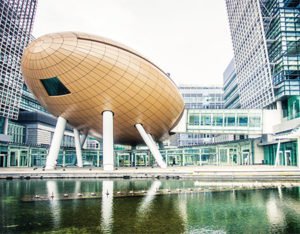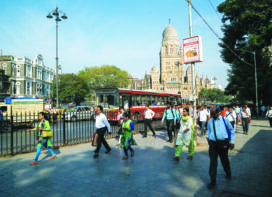With rising population density, the world’s megacities are facing ever more complex problems. This is precisely why they are also the best places for the concerted development of smart solutions for the city of the future. One example is the new Smart City Digital Hub at Hong Kong Science Park, where Mobility is one of the focus topics.
The key objectives of all Smart City projects are increasing the efficiency of all operational and administrative processes in a city, strengthening its competitive position and, most importantly, improving the quality of life for the city’s inhabitants.
 For about ten years now, urban areas have been home to more than half of the world’s population. And there is no end in sight to the rural exodus. On the contrary: Experts predict that 90 percent of future population growth will concentrate in cities. For mega cities in particular, this development is giving rise to “mega-challenges” – for instance in the areas of power supply, air quality or mobility. The good thing is that, at the same time, there are also “mega-opportunities”. Especially the fast-paced digitization trend keeps creating ever more novel options for tackling urban problems. Today’s world is more thoroughly connected than ever. Billions of smart devices and machines are generating enormous data volumes that result in the progressive fusion of the real and the virtual world. This is particularly true also for the future world of mobility (#MobilityUniverse), where road and rail infrastructures are gradually merging to form a single holistic transport landscape.
For about ten years now, urban areas have been home to more than half of the world’s population. And there is no end in sight to the rural exodus. On the contrary: Experts predict that 90 percent of future population growth will concentrate in cities. For mega cities in particular, this development is giving rise to “mega-challenges” – for instance in the areas of power supply, air quality or mobility. The good thing is that, at the same time, there are also “mega-opportunities”. Especially the fast-paced digitization trend keeps creating ever more novel options for tackling urban problems. Today’s world is more thoroughly connected than ever. Billions of smart devices and machines are generating enormous data volumes that result in the progressive fusion of the real and the virtual world. This is particularly true also for the future world of mobility (#MobilityUniverse), where road and rail infrastructures are gradually merging to form a single holistic transport landscape.
One of the places where Siemens’ pioneering engineers (#EngineersOfNext) have found excellent conditions for developing and testing innovative systems is Hong Kong. With 7.4 million inhabitants on a territory of about 1,100 square kilometers – i.e. 6,500 people per km² – the special administrative region on China’s south coast is among the five most densely populated areas in the world. This means that in Hong Kong, requirements are more complex than anywhere else and that, by implication, solutions that work in Hong Kong will also work in any other city.
Connectivity is the foundation of a Smart City
Last year, when Siemens was offered an opportunity to set up a Smart City Digital Hub in cooperation with the Hong Kong Science and Technology Parks Corporation (HKSTP), the decision was easy. Realization was just as quick: Since December 2017, the Hub now serves as an “open urban laboratory” where infrastructure operators and start-ups can implement a digital portfolio of Smart-City applications. The research and development efforts focus on the areas of Data Analytics, Internet of Things, Connectivity, Cyber Security, Embedded Computing, Smart Buildings, Smart Power and Smart Mobility.
 Infrastructure, management, transport, citizens— everything and everyone is connected and the entire system is monitored and controlled using smart applications,” says Digital Solution Manager Daniel Weitze, who is responsible for know how transfer between Siemens headquarters in Munich and the local office in Hong Kong. His work revolves mainly about digitalization topics such as Software-as-a- Service or MindSphere, Siemens’ cloud-based Internet-of-Things platform that provides data analysis functions, multiple connectivity options and a wide range of tools for developers, applications and services. At the same time, Weitze sees himself as a new type of consultant: “Today our role is not simply to try and sell our product portfolio to the customer anymore. A good consultant works together with the customer to identify any gaps and weaknesses within the current system and find out how these can be eliminated – with the help of our technologies and our experience and also through the targeted analysis of data that are available anyway.”
Infrastructure, management, transport, citizens— everything and everyone is connected and the entire system is monitored and controlled using smart applications,” says Digital Solution Manager Daniel Weitze, who is responsible for know how transfer between Siemens headquarters in Munich and the local office in Hong Kong. His work revolves mainly about digitalization topics such as Software-as-a- Service or MindSphere, Siemens’ cloud-based Internet-of-Things platform that provides data analysis functions, multiple connectivity options and a wide range of tools for developers, applications and services. At the same time, Weitze sees himself as a new type of consultant: “Today our role is not simply to try and sell our product portfolio to the customer anymore. A good consultant works together with the customer to identify any gaps and weaknesses within the current system and find out how these can be eliminated – with the help of our technologies and our experience and also through the targeted analysis of data that are available anyway.”
The perfect place to forge alliances: Already today, the Hong Kong Science Park is home to 400 to 600 companies.
The key objectives of all Smart City projects are the same: increasing the efficiency of all operational and administrative processes in a city, strengthening its competitive position and, most importantly, improving the quality of life for the city’s inhabitants. The latter is by far the most important indicator for the success of an innovative solution.
Smart Cities require that we break down the silo walls
Daniel Weitze says, “ “The center looks pretty much like a Western city, sometimes you think this could be New York. Other districts do have a typically Asian character, the streets are lined with countless small shops. And a bit farther from the center, there are many hills and beaches, where you might almost believe to have set foot on an uninhabited island.”
According to him the smart city vision requires fully integrated approaches that bring together all the different disciplines involved. The various specialists cannot concentrate exclusively on their own area of expertise if they want to develop effective concepts. Optimum results require permanent exchange and cooperation – or “breaking down the silo walls”.
Cooperative solutions promise significant added value
What the combination of Mobility and Building Technology solutions could look like is illustrated by the following – still only theoretical – scenario for the automation of emergency processes in the case of fires: As soon as the fire protection system in a building triggers an alarm, a drone is sent over for verification. While the drone is still on its way, the traffic management system already calculates the best route for the emergency vehicles so that the fire fighters can start immediately when they receive the get-go. If this is the case, the system adapts the traffic light switching routines to clear the way for the emergency vehicles at all intersections.
Besides safety, the key driving factors behind the development of integrated solutions in Hong Kong also include air quality. The city performance tool “Air”, for instance, combines more than 80 different Siemens technologies. The array of functions ranges from the measurement and analysis of current data on weather conditions, power consumption and traffic volumes, or statistics based on relevant historical parameters right up to sophisticated prognosis and simulation tools. This allows highly accurate assessment and meaningful comparison of the different available intervention options, for instance Pollution Tolling schemes or instructing the citizens to work exclusively from home on specific days.
Thanks to smart modifications, even individual devices can turn into true all-rounders: The so-called Embedded City Box, for example, was originally designed for air quality measurements. Equipped with a camera and a local processing unit for video analysis, the box becomes the perfect tool for use in the scope of “Smart Kerbside”, a pilot project for monitoring loading zones that has just been started. Initially limited to the district of Kowloon East, it may subsequently be implemented throughout the city, if the technology proves successful. The purpose: The automatic identification of loading zones that are blocked by cars so that prompt measures can be taken to make the zones accessible again.
If something looks promising, we simply go ahead and try it. If it works, the concept will later be rolled out. If it doesn’t, not much has been lost in terms of time and money.
The rapid paces are cooperations with start-ups
Kowloon East is the official “test-bed” district for implementing and trialing measures in the Smart City context. “Smart Kerbside” is one of six proof of- concept initiatives that are currently being implemented. In a second step, the results will be evaluated in a dedicated study. The other projects cover topics such as pedestrian routing, crowd management or improved energy efficiency. What all have in common is a fast-track implementation and evaluation timeline. “If something looks promising, we simply go ahead and try it,” says Daniel Weitze. “If it works, the concept will later be rolled out. If it doesn’t, not much has been lost in terms of time and money.”
Siemens’ follows a similar general strategy for developing new, smart solutions at the new Smart City Digital Hub in Hong Kong. In contrast to development projects for future seriesproduced systems, most projects here do without a predefined roadmap with multiple validation loops. It all starts with the envisaged business case or the specific customer request – and the first prototype is created as soon as possible.
The rapid pace is supported by cooperation agreements with local startups, for which creativity and speed is usually an integral part of their DNA.. “This makes the start-ups our speedboats, so to speak, that can immediately adapt their course to changing requirements and start working full-throttle on new solutions.” In Weitze’s eyes, the cooperation with inventive newcomers offers another major advantage: “In the field of traffic engineering, Siemens has been mostly active in the business to- business and business-to-government markets. Now the teamwork with people who are busy developing cool applications for consumers provides us with a lot of additional data that will help us make our systems even more performant and adaptive.”
A place that makes it especially easy to forge alliances
When looking for suitable business partners, the Hong Kong Science Park is certainly one of the best places in the world. Already today, the HKSC is home to about 400 to 600 companies of all sizes. A large part of them are active in the fields of Green Technology or Communication Technology – two areas that are going to play a leading role in the Smart Cities of the future. Then there are also several universities, who can provide valuable input for the creation of true innovation.
With permission from Siemens AG
 TrafficInfraTech Magazine Linking People Places & Progress
TrafficInfraTech Magazine Linking People Places & Progress


